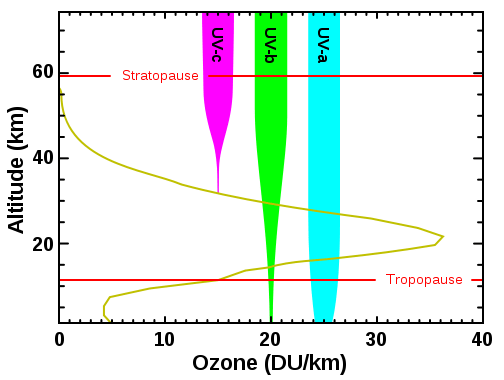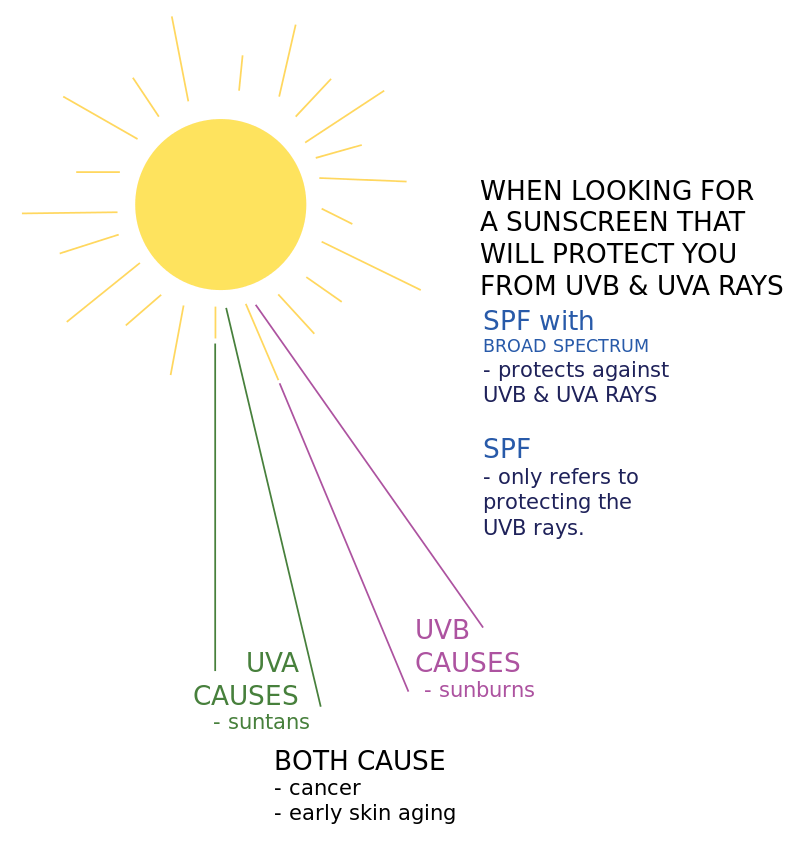What is the Difference Between UVA and UVB Rays
Table of Contents
The key difference between UVA and UVB rays is that UVA has a longer wavelength and is associated with skin aging, whereas UVB has a shorter wavelength and is associated with skin burning.
UV refers to Ultraviolet. UV is a form of electromagnetic radiation having a wavelength from 10 nm to 400 nm. This wavelength is shorter than visible light. However, it is a longer wavelength compared to that of X rays. UV light occurs in sunlight. About 10% of the total electromagnetic radiation emitted from the sun consists of UV radiation. There are two types of UV rays, including UVA and UVB.
CONTENTS
1. Overview and Key Difference
2. What are UVA Rays
3. What are UVB Rays
4. UVA vs UVB Rays in Tabular Form
5. Summary – UVA vs UVB Rays
What are UVA Rays?
UVA rays are a major component of total UV rays that reaches the Earth’s surface. UVA rays make up 95% of the total UV rays that hits the surface of Earth. According to the action spectrum of UV rays, UVA does not cause an immediate reaction. In other words, it does not cause any immediate sunburns. Therefore, there are no important data about protection against UVA rays. However, it is still harmful because it can cause indirect damage to DNA in our skin and can be carcinogenic. Furthermore, the absence of UVA filters can cause a higher incidence of melanoma that can be found in sunscreen users compared to non-users. Although most sunscreens lack UVA protectors, some lotions contain titanium dioxide, zinc oxide, and avobenzone, which can help to protect ourselves against UVA rays.

The UVA wavelength can be visible to many reptiles. Therefore, it might play an important role in the ability of reptiles to survive the wild as well as their visual communications with each other. Meanwhile, UVA rays are hardly affected by the ozone layer, which may be the cause why most of the UVA reach Earth’s surface.
What are UVB Rays?
UVB rays are the minor component of total UV rays that reaches the Earth’s surface. UVB has a comparatively shorter wavelength, and about 5% of the UV rays that reach the ground are UVA rays. Therefore, it has a medium energy level compared to UVA and UVC. Cells in the top layer of the skin are affected by UVB rays. There can be some short-term effects such as delayed tanning, sunburn, and blistering. The long-term effects on the skin would include skin cancer, contribution to premature aging, etc. Moreover, UVB rays can directly damage DNA.

The amount of UVB that reaches the ground is determined by the ozone layer because most of the UVB rays are filtered out by the ozone layer. Moreover, the content of UVB in UV rays after passing the atmosphere is largely dependent on cloud cover and atmospheric conditions.
UVB rays play a major role in the development of plants. This is because it can affect most plant hormones. However, UVB rays can cause direct damage to our DNA. Therefore, it can contribute to skin cancers. UVB rays can excite DNA molecules in skin cells, which can cause aberrant covalent bonds that are formed between adjacent pyrimidine bases. This produces a dimer.
Furthermore, reptiles require UVB rays for the biosynthesis of vitamin D. Some of their metabolic processes are dependent on these rays. E.g. Cholecalciferol (Vitamin D3) production.
What is the Difference Between UVA and UVB Rays?
UV refers to Ultraviolet. There are two types of UV rays: UVA and UVB. UVA rays are the major component of total UV rays that reaches the Earth’s surface. UVB rays are the minor component of total UV rays that reaches the Earth’s surface. The key difference between UVA and UVB rays is that UVA has a longer wavelength and is associated with skin aging, whereas UVB has a shorter wavelength and is associated with skin burning.
The below infographic presents the differences between UVA and UVB rays in tabular form for side by side comparison.
Summary – UVA vs UVB Rays
UVA rays are the major component of total UV rays that reaches the Earth’s surface. UVB rays are the minor component of total UV rays that reaches the Earth’s surface. The key difference between UVA and UVB rays is that UVA has a longer wavelength and is associated with skin aging, whereas UVB has a shorter wavelength and is associated with skin burning.
Reference:
1. Vandergriendt, Carly. “UVA vs. UVB Rays: What’s the Difference?” Healthline, Healthline Media, 12 Sept. 2019.
Image Courtesy:
1. “Ozone altitude UV graph” By NASA – [1] (Public Domain) via Commons Wikimedia
2. “Sun rays diagram” By GRPH3B18 – Own work (CC BY-SA 3.0) via Commons Wikimeida
ncG1vNJzZmivp6x7pbXFn5yrnZ6YsqOx07CcnqZemLyue9ahmK1lmah6tbTEZpuinpaav6a6wp5km52krLKmuoyurZplkaOxbsHVm2SrmamofA%3D%3D